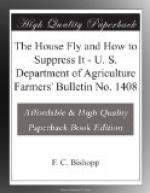Sprays designed to destroy or repel house flies fill a certain need in connection with the house-fly problem. No very satisfactory repellent substances for this insect have been found which are at the same time adaptable to general use about the home, or places where foods are handled. Extracts of pyrethrum flowers are now generally available commercially, and these give fairly good results in the destruction of house flies in buildings. Most of the sprays of pyrethrum extract contain kerosene oil as a carrier, and undoubtedly the kerosene has much to do with the toxicity of the spray. Such materials are most applicable to buildings which become infested with flies and which can be readily closed up at night and the air within thoroughly saturated with the spray by means of an atomizer. Under such conditions the flies are rather quickly overcome by the spray and if a sufficient quantity is used they will not revive.
FLYTRAPS.
Flytraps may be used to advantage in decreasing the number of flies. Their use has been advocated not only because of the immediate results, but because of the chances that the flies may be caught before they lay eggs, and the number of future generations will be reduced greatly.
Many types of flytraps are on the market. As a rule the larger ones are the more effective. Anyone with a few tools can construct flytraps for a small part of the price of the ready-made ones. A trap (fig. 8) which is very effective in catching flies and is easily made, durable, and cheap, may be made of four barrel hoops, four laths, a few strips of boxing, and 8 1/2 lineal feet of screening, 24 inches wide. (For greater details see Farmers’ Bulletin 734.)
The effectiveness of the traps will depend on the selection of baits. A good bait for catching house flies is 1 part of blackstrap molasses to 3 parts of water, after the mixture has been allowed to ferment for a day or two. Overripe or fermenting bananas crushed and placed in the bait pans give good results, especially with milk added to them. A mixture of equal parts brown sugar and curd of sour milk, thoroughly moistened, gives good results after it has been allowed to stand for three or four days.
PREVENTING THE BREEDING OF FLIES.
As previously stated, fly papers, poisons, and traps are at best only temporary expedients. The most logical method of abating the fly nuisance is the elimination or treatment of all breeding places. It would appear from what is known of the life history and habits of the common house fly that it is perfectly feasible for cities and towns to reduce the numbers of this annoying and dangerous insect so greatly as to render it of comparatively slight account. On farms also, in dairies, and under rural conditions generally, much can and should be done to control the fly, which here, as elsewhere, constitutes a very serious menace to health.




